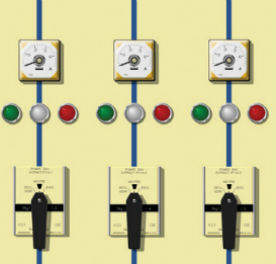A project to supply an L3 Mapps full-scope operator training simulator (FSS) to Electrabel for the Tihange 1 nuclear power plant in Belgium began in December 2013. Tractebel Engineering is leading the project. By Kim Scott and Vincent Gagnon, L-3 Communications MAPPS Inc.

Electrabel operates seven nuclear reactors, four at Doel and three at Tihange, with a total nuclear capacity of almost 6000 MW. Tihange 1 is a three-loop pressurized water reactor with an electrical output of 962 MW. The plant was commissioned in 1975 and, on 4 July 2012, the Federal Agency of Nuclear Control decided to extend the operational life of Tihange 1 by ten years until 2025. Tihange 1 is operated by Electrabel and is jointly owned by Electrabel and EDF.
Tihange 1 operators are currently trained on the Tihange 2 full-scope simulator. Training on Tihange 1 will be considerably improved with a simulator that is specifically referenced to Tihange 1, and is nearly identical to its main control room.
The Tihange 1 FSS, equipped with full replica control room panels, will use L-3 MAPPS’ state-of-the-art Orchid® graphical simulation PC/Windows-based tools for the plant models and instructor station. The plant systems will be simulated in the Orchid® simulation environment, including the reactor, nuclear steam supply systems, balance of plant systems, the electrical AC and DC distribution systems, and I&C systems. The electrical grid, including the main generators and transformers, will be modelled with FAST®, a product of Tractebel Engineering.
L-3 MAPPS is working closely with subcontractor Cofely Fabricom Industrie Sud that will provide the FSS panels and consoles. CFIS is also a member of GDF SUEZ group and is located in Ans, Belgium. CFIS built the original Tihange control room panels as well as the Tihange 2 FSS panels in the 1990s. Another subcontractor involved with the project is Brussels-based Macq Traffic & Automation that will provide a stimulated data acquisition system, the Traitement Centralisé de l’Information.
In parallel, Electrabel is constructing a brand-new training building that will house the new FSS. Ground works began in the spring of 2014 and the training building is slated to be completed by summer 2015, just in time for the on-site installation of the simulator. It will also accommodate an instructor facility, classroom simulator and debriefing rooms.
All of the system models, with the exception of the reactor kinetics model and the FAST models, are developed using Orchid® Modeling Environment. Reactor data will be generated using PANTHER (an advanced 3-D nodal code for reactor core analysis). The models will be validated against available plant data, design data and/or other plant information such as safety analysis reports. An extensive set of tests, consisting of normal and abnormal plant operations as well as major accidents, is performed by the Electrabel/Tractebel Engineering/L-3 MAPPS teams dedicated to the simulator validation. As a minimum, simulator performance is tested in accordance with the ANSI/ANS-3.5-2009 standard.
The Tihange 1 plant control panels, reproduced using Orchid® Graphic Editor, can show additional information visible only to the simulator instructor to provide better feedback and control.
The I/O system selected for simulator communication with panel instrumentation is based on Beckhoff technology; L-3 MAPPS is incorporating a dedicated I/O PC to ensure optimal performance of the signal conversion and communication.
Project execution
The Tihange 1 FSS project consists of an intricate hardware and software effort needed to make the simulator operational. L-3 MAPPS will complete the software development and will develop the software configuration, and integrate, test and deliver hardware panels and consoles delivered by CFIS and TCI from Macq. L-3 MAPPS and Tractebel Engineering are responsible for delivering the entire simulator to Electrabel.
L-3 MAPPS is developing the software models using the Orchid® toolset in L-3 MAPPS’ facility in Montreal, Canada. At the same time, there will be a test site set up at a facility in Belgium that will contain the control room replica of the panels and consoles.
By executing the project with much of the work performed in parallel, it is believed to mitigate risks and reduce the overall aggressive schedule (it is to be ready for training by spring 2016). Furthermore, having part of the project executed in Belgium will facilitate more frequent visits by Electrabel so that adjustments can be made earlier in the project rather than later. It is also beneficial to utilize subcontractors already familiar with the actual Tihange 1 control room and systems such as CFIS and Macq.
After the Tihange 1 FSS is delivered, there are already plans for the implementation of changes to an upgraded (expanded) remote emergency shutdown control room. L-3 MAPPS looks forward to the years of collaboration with Electrabel and Tractebel Engineering to come.
